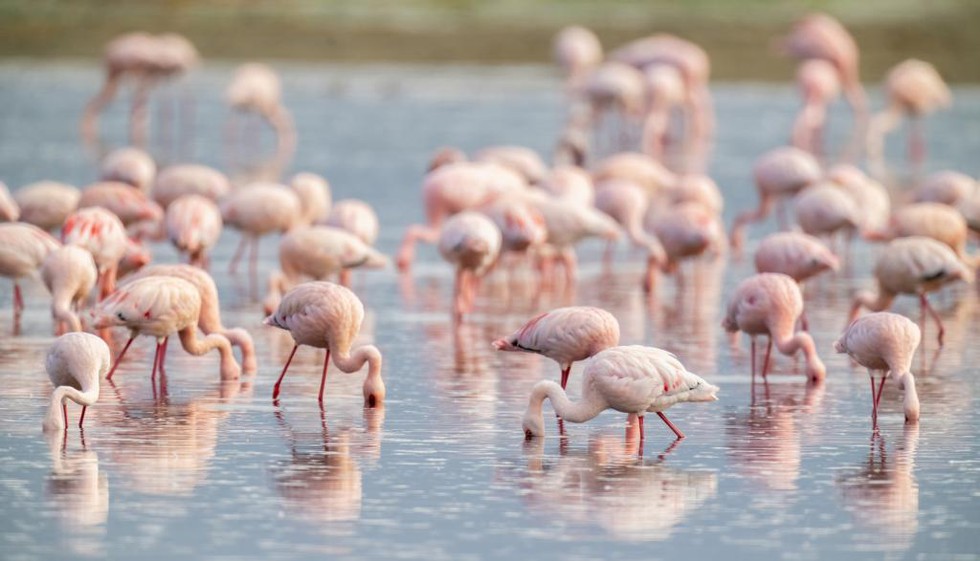Millions of pink flamingos transform the alkaline waters of Lake Natron in northern Tanzania into a dazzling sea of fluttering feathers every day. This enchanting display, however, is under threat. Human activities and changing weather patterns are threatening the world’s largest migratory bird colony, prompting environmentalists to issue a warning.
Dangerous but Hospitable Lakes
Africa’s Great Rift Valley is home to some of the world’s most dangerous lakes. Lake Natron in Tanzania and Lake Bogoria in Kenya are hostile to most forms of life, with surface temperatures soaring up to 40 degrees Celsius. However, these are perfect habitats for flamingos. These lakes, filled with caustic soda and hypersaline water, deter most predators but provide an unexpected haven for fascinating migratory birds.
Unique Composition of Lake Natron
Lake Natron, a Ramsar site on the Tanzania-Kenya border, has a unique composition of warm waters and salt, caustic soda, and magnesite deposits that provide ideal conditions for flamingos to thrive. However, this delicate equilibrium is increasingly being upset.
Human Activities and Climate Change
Several factors, including agriculture, pollution, and climate change, are threatening the beauty of this unique ecosystem, according to John Sule, a senior ecologist. “Climate change is altering water levels and salinity, making it harder for flamingos to find suitable nesting sites. The population of flamingos on Lake Natron is steadily declining as fewer birds return each year due to extreme weather and encroachment,” he said.
Effects of Extreme Weather
Extreme weather is causing frequent flooding, compromising the lake’s salinity. “The reduction in salinity disrupts the growth of specific algae that serve as a food source for flamingos. The birds’ feeding patterns and breeding success are being adversely affected, posing a serious threat to their population,” said Sule. Conversely, prolonged dry seasons are also causing water levels to drop dangerously, concentrating the lake’s salinity beyond what algae can tolerate and resulting in flamingo food shortages.
Industrial Threats
In 2006, an Indian company proposed a soda ash extraction project at Lake Natron, which sparked global outrage and was ultimately abandoned in 2008. The threat, however, persists. “Flamingos are incredibly sensitive to changes in their environment,” said Edmund Shayo, an environmental activist specializing in bird habitats. “The rising water levels are diluting the soda lakes, which drastically affects the cyanobacteria that flamingos feed on.” According to Shayo, mining activities near the lake are detrimental to the birds. “The disruption caused by mining activities would most likely force them to abandon the lake. Flamingos need a quiet and undisturbed environment for nesting and any significant disturbance could drive them away, threatening their ability to reproduce and sustain their population,” he said.
Local Community Initiatives
Despite the challenges, local communities are actively working to protect their pink-feathered neighbors. Yohanna Mlai, a resident of Magadini village, believes that education plays a crucial role in these efforts. By teaching pastoral communities about sustainable water practices, they aim to ensure that the lake remains a viable habitat for both flamingos and the people who depend on it. This initiative is helping to balance the needs of wildlife with those of the local human population, fostering a sense of stewardship and coexistence.
Economic Importance
“The importance of Lake Natron’s flamingos extends beyond their ecological role. They are a major attraction, drawing thousands of tourists every year,” Mlai said. Tourism accounts for 17.2 per cent of the country’s gross domestic product and 25 per cent of foreign exchange revenues.
Global Patterns and Indicators
Flamingos’ struggle for survival in Tanzania is part of a broader global pattern. Across Africa’s Great Rift Valley, flamingos face similar threats at other critical breeding sites. Rising water levels and invasive plant species, fueled by climate change, are disrupting these habitats. “These birds are vital environmental indicators,” said Flower Msuya, a marine biologist at the University of Dar es Salaam. “Their well-being is a reflection of the overall health of the ecosystem. When flamingos face difficulties, it indicates larger environmental issues that must be addressed.”
Comprehensive Conservation Strategies
To protect Tanzania’s flamingos, comprehensive and coordinated efforts are required. Conservationists advocate for stricter environmental regulations and increased public awareness. “Protecting these birds requires a holistic approach,” said Msuya. “It’s about preserving their habitat, controlling pollution, and ensuring that any development around the lake is sustainable. Communities must be at the forefront of conservation efforts. Their involvement and cooperation are crucial for any long-term success.”
Conclusion
We must act now, urged Sule. “If we don’t address these issues, we risk losing one of nature’s most spectacular phenomena,” he said.
Multiple Choice Questions (MCQs):
- What is causing the decline in flamingo population at Lake Natron?
- A. Predators
- B. Extreme weather and encroachment
- C. Lack of food
- D. Overhunting
- What is the primary composition of Lake Natron that makes it ideal for flamingos?
- A. Freshwater and low temperatures
- B. Warm waters, salt, caustic soda, and magnesite deposits
- C. High levels of vegetation
- D. High population of fish
- Which factor is NOT mentioned as a threat to flamingos at Lake Natron?
- A. Climate change
- B. Industrial mining
- C. Invasive species
- D. Overfishing
- What role does tourism play in the local economy according to Yohanna Mlai?
- A. It is negligible
- B. It accounts for 17.2% of GDP and 25% of foreign exchange revenues
- C. It only benefits a few individuals
- D. It has no impact on the flamingo population
- Why are flamingos considered vital environmental indicators according to Flower Msuya?
- A. They are the most numerous birds
- B. Their well-being reflects the overall health of the ecosystem
- C. They are easy to observe
- D. They do not migrate
